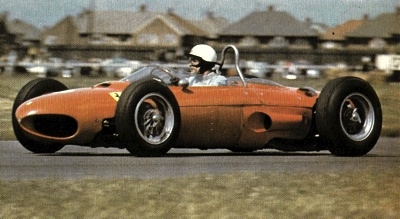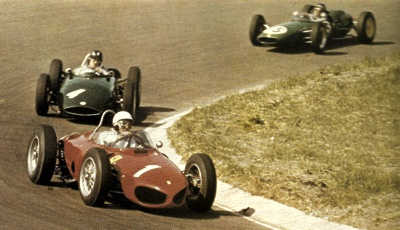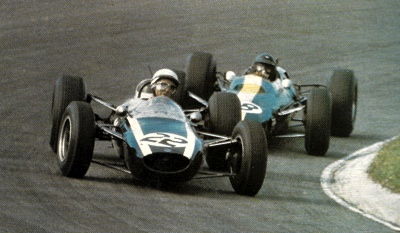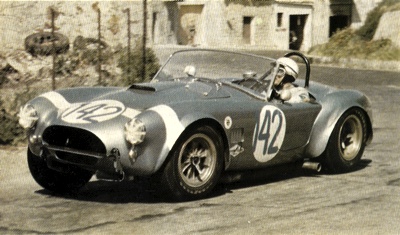The Cinder Speedway Tracks
in the years after World War 2 Sports Car racing began to gain a hold here in the United States. Prior to the war most motor racing was on banked ovals or on the cinder speedway tracks, and the drivers did not aspire to race on European road circuits. However, many US servicemen discovered the sports car when they visited Europe during the war and the delights of open air motoring were soon being exercised on home soil.
The drivers of these cars began to race them and inevitably organized races were soon being held. European racing drivers and other enthusiasts were openly contemptuous of the American racing scene because they felt that Europeans were far more suited to road racing, but the first of many Americans to surprise Europe was Phil Hill, who became the first American driver to win the World Drivers Championship.
Pebble Beach
Born in Miami, Florida in 1927, Philip T. Hill moved to Santa Monica, California, where his father became head, postmaster. California was the centre of the sports car boom in the late 1940s and early 1950s and Phil Hill soon joined in with the almost mandatory
MG TC, which he began to race to good effect. By
1952 he was coming to the notice of sports car enthusiasts and in that season he won his first race at the famous Pebble Beach Course at Monterey in California.
Hill joined forces with
Richie Ginther in
1953 for the Carrera Panamerica race, with Hill driving and Ginther acting as mechanic in a
Ferrari. Hill crashed in this race but the next year the Hill/Ginther duo finished second behind the works
Ferrari of Umberto Maglioli. Hill was already receiving sponsored drives by
1953, because importers of sporting machinery saw the value of competition success as a sales booster. He visited Europe in
1954 to drive an
Osca with Fred Wacker at Le Mans but the car retired after leading its class comfortably.
Partnering with Carroll Shelby
In
1955 Hill drove a 3-liter Ferrari Monza sports racing car for wealthy private owner Alan Guiberson and, partnered by Carroll Shelby, he finished second in the
Sebring 12 Hour race, although many people felt that faulty lap scoring had robbed the pair of victory. By
1956 the American Ferrari importer, former racing driver Luigi Chinetti, had persuaded
Enzo Ferrari to give Phil Hill some drives in the works team atid his first drive with them was the Buenos Aires 1000 Kilometre race where, partnered by Olivier Gendebien, he finished second. He finished third in the
Nurburgring 1000 Km race and then ended the sports car season with victory in the Swedish Grand Prix, partnered by Maurice Trintignant in a 3.5-liter Ferrari. He also won the non-Championship Messina 5hr race and finished second in the Porto GP at Boavista.
Hill stayed with the Ferrari sports car team for
1957, winning the Venezuelan GP with
Peter Collins in a 4.1-liter
Ferrari, finishing second in the Reims 12 Hours and the Swedish GP, and winning the Palm Springs race back home in California. By now Hill was regarded as a fast, consistent driver, who was ideally suited for long distance races as he usually managed to bring the car home, but in
1958 he joined the Ferrari Formula One team, finishing in excellent third places at the Italian and Moroccan Grands Prix. But it was in sports car racing that Hill shone, as he captured no less than three long distance races, the Argentine 1000 Km, the
Sebring 12 Hours, and the Le Mans 24 Hour race. This enabled Ferrari to run away with the World Sports Car Championship for the third year in succession.
In
1959 Hill drove the big front-engined F1 Ferrari against the fleet smaller rear-engined cars and had little luck apart from second places in the French and Italian GPs and a third at the German GP. In sports car racing
Aston Martin were all-conquering during
1959, so Hill had to take a back seat for a change, but he and Gendebien won the
Sebring 12 Hours again as well as taking second place in the
Nurburgring 1000 Km. Hill also won the Riverside sports car race in a Ferrari.
 Phil Hill in 1961, America's first World Champion. He is pictured here driving a rear engined V6 Ferrari.
Phil Hill in 1961, America's first World Champion. He is pictured here driving a rear engined V6 Ferrari.
 Phil Hill's Ferrari leads Graham Hill's BRM and the Lotus Climax of Jim Clark at the 1961 Dutch Grand Prix.
Phil Hill's Ferrari leads Graham Hill's BRM and the Lotus Climax of Jim Clark at the 1961 Dutch Grand Prix.
 Phil Hill in a Cooper Climax.
Phil Hill in a Cooper Climax.
 Phil Hill in an AC Cobra.
Phil Hill in an AC Cobra. |
Cliff Allison
The
1960 season gave Phil Hill his first victory in a Championship F1 race, with a win at the Italian GP, but the rest of his Formula One season was uneventful, his only other placings of note being a third at Monaco, and a fourth at the Belgian GP. He was still driving for
Ferrari in sports car races but his only win in
1960 was the Argentinian 1000 Km with Cliff Allison as co-driver; however, he finished second in the Targa Florio with von Trips and third in the Niirburgring 1000 Km. The 1961 season saw the introduction of the 1.5-liter Formula One, a step with which the British teams disagreed.
The Ferrari team got on with the job of designing new cars for the Formula while the British hesitated, so that at the opening meetings of the season the Ferrari drivers were a little faster than their rivals - all except
Stirling Moss who sometimes, and somehow, managed to beat them with his outdated Lotus, probably by sheer skill.
Wolfgang von Trips was the fastest of the Ferrari drivers but Hill was consistent, finishing third at Monte Carlo, second at the Dutch GP. Then he won the Belgian GP at
Spa, finished second at the British GP and then third at the German GP.
At the Italian GP it seemed that
von Trips could clinch the World title but on the second lap he touched
Jim Clark's Lotus and his car shot up a bank into the crowd, killing six spectators and the driver. This left Phil Hill to cruise on to an easy and unhappy victory which gave him the World Championship, but it was a shallow victory. He was even denied the opportunity of racing in front of his home crowds as Ferrari withdrew from the United States GP which ended the season.
The Greatest Racing Partnership Of All Time
In sports car racing Hill helped Ferrari to another Manufacturers Championship victory with wins at
Sebring and Le Mans again, partnered once more by Gendebien. The British constructors had caught up with Ferrari by
1962 and Hill's successes were less numerous that season. He picked up a third place at the Dutch GP, second at Monaco and third at the Belgian GP, but after that the Ferrari challenge faded away and Hill did not score another point. In truth, Hill was not a natural Formula One driver, he prefered the challenge of sports car racing where he and Gendebien formed arguably the greatest racing partnership of all time. Together, they won the
Nurburgring 1000 Km and
Le Mans yet again in 1962 and finished second at
Sebring in a Ferrari GTO to give Ferrari another world title.
The Daytona Continental
Relations between Hill and
Enzo Ferrari deteriorated during
1962, as the dictatorial Ferrari blamed Hill for the lack of success in Formula One racing; eventually Hill fell out with Ferrari over this and decided to join the new ATS concern for
1963. This Formula One venture was disastrous, as the car handled poorly and the engine was unreliable, so much so that Hill hardly ever finished a race. For
1964 Hill joined the Cooper team for Formula One races to drive the Cooper-Climax 1.5-liter but Cooper were in decline and his only Championship placing was a sixth at the British GP.
The Chaparral Team
In sports cars Hill won the Daytona Continental race with
Pedro Rodriguez in a Ferrari then switched to the new AC Cobra and
Ford GT40, neither of which brought him any success. In
1965 Hill retired from Formula One racing to concentrate on sports cars. He drove factory
Ford GT40s and Mk 1 models in Championship events but he retired in all but one event. For
1966 Hill decided to join the Chaparral team in sports car racing, the
Chevrolet V8 engined coupe creating attention wherever it appeared. Partnered by
Jo Bonnier, Hill showed the quality of the car by leading several races before retiring. But victory eventually came in the
Nurburgring 1000 Km race.
Hill also drove an open Chaparral with a huge free-standing aerofoil in the first Can-Am series in
1966; the car proved to be very fast and he won the Laguna Seca round, finished second at Mosport and seventh at Las Vegas, to wind up fourth in the Championship. Hill stayed with the Chaparral team in
1967 to drive the new coupe 2F model with large rear mounted aerofoil. Again the car was very fast, putting in a number of fastest laps, but it was not until the
BOAC 500 at Brands Hatch that victory finally came to Hill, partnered this time by the British driver, Mike Spence.
It proved, a fitting end to Hill's career, and he retired at the end of the
1967 season. He had suffered from poor health for some time which had limited his performances at times. It was discovered that he had been suffering from stomach ulcers and when he was operated on his health improved considerably. There was no telling how well Hill would have done if his health had been perfect, but he was content to retire, keeping in contact with the sport by doing commentaries on TV Phil Hill was inducted into the International Motorsports Hall of Fame in 1991, and sadly passed away on August 28th, 2008.
Also see: Phil Hill (AUS Edition) 